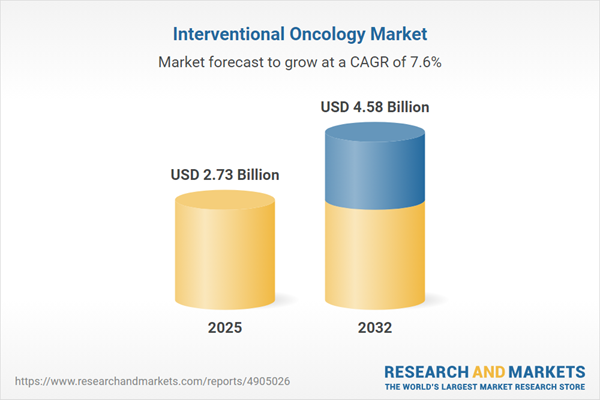Speak directly to the analyst to clarify any post sales queries you may have.
Interventional oncology is rapidly shaping the future of cancer care, empowering healthcare providers and industry stakeholders with minimally invasive treatment solutions that blend precision with patient-centricity. As this segment matures, decision-makers face both new opportunities and persistent complexities that require strategic insight and adaptable business frameworks.
Market Snapshot: Interventional Oncology Market Size and Growth
The Interventional Oncology Market grew from USD 2.55 billion in 2024 to USD 2.73 billion in 2025. It is expected to continue growing at a CAGR of 7.58%, reaching USD 4.58 billion by 2032. Robust market expansion is underpinned by advancing therapeutic modalities and increasing demand for minimally invasive interventions across emerging and established healthcare environments.
Scope & Segmentation
This report provides a structured view of the interventional oncology ecosystem, covering major segments and regions, as well as critical technologies and applications driving adoption:
- Product
- Ablation Devices: Cryoablation, High-Intensity Focused Ultrasound, Laser Systems
- Embolization Devices: Drug-Eluting Beads, Microspheres
- Supportive Devices: Guidewires, Introduction Kits
- Cancer Type
- Colorectal Cancer, Kidney Cancer, Liver Cancer, Lung Cancer
- Technology
- Brachytherapy, Image-Guided Radiotherapy, Microwave Ablation, Radiofrequency Ablation
- End-User
- Ambulatory Surgical Centers, Cancer Research Institutes, Hospitals
- Geography
- Americas: United States, Canada, Mexico, Brazil, Argentina, Chile, Colombia, Peru
- Europe, Middle East & Africa: United Kingdom, Germany, France, Russia, Italy, Spain, Netherlands, Sweden, Poland, Switzerland, United Arab Emirates, Saudi Arabia, Qatar, Turkey, Israel, South Africa, Nigeria, Egypt, Kenya
- Asia-Pacific: China, India, Japan, Australia, South Korea, Indonesia, Thailand, Malaysia, Singapore, Taiwan
- Leading Companies
- Abbott Laboratories, ABK Biomedical Inc., Accuray Incorporated, AngioDynamics, Inc., Bayer AG, Boston Scientific Corporation, Cook Group Incorporated, Eckert & Ziegler BEBIG AG, Fujifilm Holdings Corporation, GE HealthCare Technologies Inc., IceCure Medical Ltd., Integer Holding Corporation, Johnson & Johnson Services, Inc., Koninklijke Philips N.V., Medtronic PLC, Merit Medical Systems, Inc., Siemens Healthineers AG, Sirtex Medical Limited, Sonablate Corp, STARmed Co., Ltd., Stryker Corporation, Surgnova Healthcare Technologies (Zhejiang) Co., Ltd., Teleflex Incorporated, Terumo Corporation, Becton, Dickinson and Company
Key Takeaways for Senior Decision-Makers
- Interventional oncology is transitioning from a niche specialty to a central pillar of multidisciplinary cancer care, driven by a preference for less invasive interventions.
- Technological advances, including the integration of artificial intelligence and robotics in image guidance and ablation procedures, enhance procedural accuracy and operator efficiency.
- Multimodal treatment pathways, such as the combination of locoregional therapies with immunotherapy, are broadening clinical utility and promoting personalized approaches.
- Regulatory reforms and reimbursement strategies are influencing adoption patterns and prompting healthcare organizations to emphasize value-based care models.
- Manufacturers are expanding their R&D pipelines through collaborations with academic and clinical partners, fueling innovation in device performance and procedural safety.
- Geographic variations in healthcare infrastructure, market access, and regulation shape the pace and scale of advanced therapy adoption, particularly in the Americas, EMEA, and Asia-Pacific regions.
Impact of United States Tariff Adjustments on Supply Chains
The revision of U.S. tariffs in 2025 has altered the cost structure for both manufacturers and healthcare providers in the interventional oncology market. Higher import duties on devices have led to a shift in procurement strategies and driven some manufacturers to pursue nearshoring or diversify production to minimize risk. The changes have also encouraged greater emphasis on bundled service models and outcomes-based contracts, supporting a broader shift toward cost optimization and operational resilience across the sector.
Methodology & Data Sources
This report is built on a rigorous hybrid research approach, combining extensive primary interviews with interventional radiologists, oncologists, and procurement specialists, alongside secondary validation from leading medical journals, regulatory repositories, and market intelligence sources. Data triangulation and expert reviews ensure the accuracy and relevance of segmentation and trend analyses.
Why This Interventional Oncology Market Report Matters
- Gain actionable insights to inform product development, investment, and partnership strategies in a competitive landscape.
- Understand evolving regulatory, reimbursement, and adoption dynamics across key global healthcare markets, enhancing commercial planning.
- Leverage evidence-based segmentation analysis to refine targeting, portfolio management, and resource allocation decisions.
Conclusion
The interventional oncology market is set for continued transformation, driven by advances in technology, regulatory adaptation, and collaborative innovation. Strategic alignment and evidence-based decision-making will be critical to realizing future growth and delivering value to both providers and patients.
Additional Product Information:
- Purchase of this report includes 1 year online access with quarterly updates.
- This report can be updated on request. Please contact our Customer Experience team using the Ask a Question widget on our website.
Table of Contents
3. Executive Summary
4. Market Overview
7. Cumulative Impact of Artificial Intelligence 2025
Companies Mentioned
The companies profiled in this Interventional Oncology market report include:- Abbott Laboratories
- ABK Biomedical Inc.
- Accuray Incorporated
- AngioDynamics, Inc.
- Bayer AG
- Boston Scientific Corporation
- Cook Group Incorporated
- Eckert & Ziegler BEBIG AG
- Fujifilm Holdings Corporation
- GE HealthCare Technologies Inc.
- IceCure Medical Ltd.
- Integer Holding Corporation
- Johnson & Johnson Services, Inc.
- Koninklijke Philips N.V.
- Medtronic PLC
- Merit Medical Systems, Inc.
- Siemens Healthineers AG
- Sirtex Medical Limited
- Sonablate Corp
- STARmed Co., Ltd.
- Stryker Corporation
- Surgnova Healthcare Technologies (Zhejiang) Co., Ltd.
- Teleflex Incorporated
- Terumo Corporation
- Becton, Dickinson and Company
Table Information
| Report Attribute | Details |
|---|---|
| No. of Pages | 198 |
| Published | November 2025 |
| Forecast Period | 2025 - 2032 |
| Estimated Market Value ( USD | $ 2.73 Billion |
| Forecasted Market Value ( USD | $ 4.58 Billion |
| Compound Annual Growth Rate | 7.5% |
| Regions Covered | Global |
| No. of Companies Mentioned | 26 |









